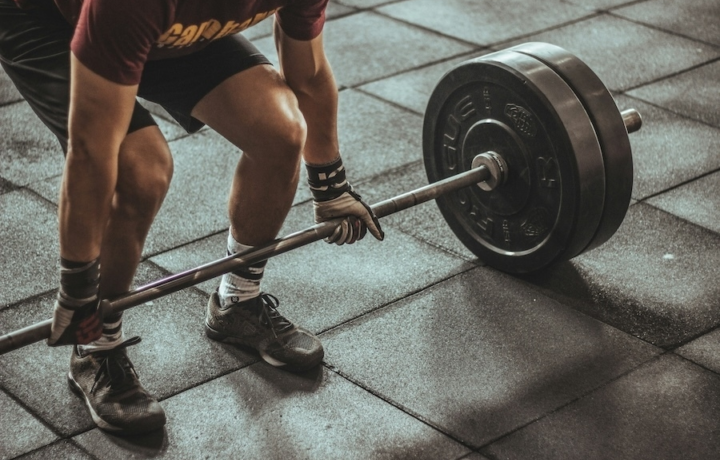Exercise
Kettlebell One Legged Deadlift

Kettlebell One Legged Deadlift
How to Perform
- Stand tall with feet hip-width apart, holding a kettlebell in your right hand with an overhand grip close to your body.
- Shift your weight to your left foot, maintaining a slight bend in the knee while keeping your right foot lightly touching the ground for initial balance.
- Hinge at your hips and maintain a neutral spine as you slowly lift your right leg straight behind you, creating a counterbalance to your forward movement.
- Lower the kettlebell toward the floor by extending your right arm down while keeping your shoulders square and back flat, breathing in during the descent.
- Continue lowering until you feel a stretch in your standing leg's hamstring, stopping when your torso is parallel to the floor or slightly higher depending on your flexibility.
- Maintain balance by engaging your core and focusing your gaze on a fixed point on the floor about two feet in front of you.
- Drive through your left heel and contract your glutes to return to the starting position, exhaling as you rise and keeping your raised leg extended until you're fully upright.
- Complete all repetitions on one side before switching the kettlebell to your left hand and balancing on your right foot.
Important information
- Keep your standing leg slightly bent throughout the movement to protect your knee joint and engage the hamstrings properly.
- If you're struggling with balance, position yourself near a wall or sturdy object for support until you develop more stability.
- Start with a lighter kettlebell until you master the form, then progressively increase the weight as your strength and balance improve.
- Ensure your hips stay square to the floor throughout the exercise to prevent rotation and maintain proper alignment.

Kettlebell One Legged Deadlift
Exercise Details
Primary Muscles
Muscle Groups
Mechanic
Risk Areas
Built for progress
Take the guesswork out of training
Create personalized AI-powered workout plans that evolve with you. Train smarter, track every rep and keep moving forward, one workout at a time.






The Kettlebell One Legged Deadlift stands as a remarkable intermediate-level exercise that challenges your balance while simultaneously building impressive strength in your posterior chain. This unilateral movement primarily targets the glutes and hamstrings, making it a staple for both bodybuilding enthusiasts looking to sculpt defined legs and HIIT devotees seeking efficient strength-building movements.
Unlike traditional deadlifts, this variation demands stabilization through your core and supporting leg, creating a unique training stimulus that addresses muscle imbalances between your left and right sides. The kettlebell's offset weight distribution adds another dimension of difficulty, forcing your body to recruit additional stabilizing muscles that might otherwise remain dormant during conventional lifts.
What makes this exercise particularly valuable is its functional carryover to everyday movements and athletic performance. The single-leg stance mimics the biomechanics of running, jumping, and changing direction – all while building the posterior strength that powers these activities. For strength athletes, this translates to improved force production and reduced injury risk during more demanding compound movements.
The beauty of the Kettlebell One Legged Deadlift lies in its versatility. It can be programmed as a primary strength movement, incorporated into a high-intensity circuit, or used as a finisher to thoroughly fatigue the glutes and hamstrings. The exercise's adaptability makes it suitable for various training goals – whether you're aiming to build muscle mass, enhance athletic performance, or simply develop functional strength for daily activities.
Beyond the physical benefits, mastering this challenging movement builds mental fortitude. The focus required to maintain proper alignment while balancing on one leg develops mind-muscle connection and proprioceptive awareness that transfers to virtually all other training modalities. For intermediate lifters ready to progress beyond basic movements, the Kettlebell One Legged Deadlift represents a perfect stepping stone toward more advanced unilateral training.
FAQ - Kettlebell One Legged Deadlift
The Kettlebell One Legged Deadlift primarily targets your posterior chain, with emphasis on the glutes and hamstrings of your working leg. It also significantly engages your core, lower back, and stabilizing muscles throughout the entire leg, making it an excellent unilateral strength developer.
The three most critical errors are allowing the hips to sag (losing the pike position), shoulders rolling forward (compromising joint safety), and excessive body wobbling due to poor core bracing. Focus on maintaining a straight line from hands to hips, keeping shoulders packed away from ears, and engaging your core throughout the movement.
If balance is challenging, try performing the exercise next to a wall or sturdy object for support. You can also start with a lighter kettlebell or even bodyweight only until your stabilizing muscles adapt. Another effective modification is reducing the range of motion initially, gradually working toward a full hip hinge as your balance improves.
Incorporate this exercise 1-2 times weekly, using 3-4 sets of 8-12 reps per leg. It works best early in your workout after a thorough warm-up when your stabilizing muscles aren't fatigued. This exercise pairs well with bilateral lower body movements like squats or conventional deadlifts for complete lower body development.
For those with existing back problems, consult with a healthcare provider before attempting this exercise. When performed correctly with proper hip hinging and neutral spine position, it can actually strengthen the supporting muscles around the spine. Start with light weights and focus on maintaining core engagement throughout the movement to protect your back.







